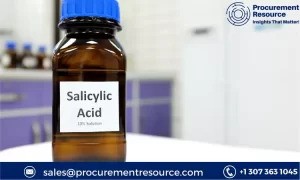In the ever-evolving landscape of the chemical industry, understanding the intricacies of production cost is paramount for strategic decision-making. The Salicylic Acid Production Cost Analysis Report offers a comprehensive evaluation of the cost structures involved in the production of salicylic acid. This in-depth report is designed to provide stakeholders with critical insights into the various cost factors, enabling them to optimize their production processes and enhance profitability.
Request For Free Sample: https://www.procurementresource.com/production-cost-report-store/salicylic-acid/request-sample
Procurement Resource Assessment of Salicylic Acid Production Process
Procurement Resource Assessment is a vital component of the Salicylic Acid Production Cost Analysis Report. This assessment focuses on evaluating the procurement process for raw materials and resources necessary for salicylic acid production. It involves a detailed examination of supplier networks, sourcing strategies, and the cost implications of different procurement methods.
The report analyzes the procurement process from multiple angles, including the identification of key suppliers, the evaluation of supply chain efficiency, and the assessment of potential risks and mitigation strategies. By understanding the nuances of procurement, businesses can better manage their supply chains, reduce costs, and ensure a steady supply of high-quality raw materials.
Product Definition
Salicylic acid is a monohydroxybenzoic acid, a type of phenolic acid, and a beta hydroxy acid (BHA). It is widely used in various industries, including pharmaceuticals, cosmetics, and food preservation. In the pharmaceutical sector, salicylic acid is a key ingredient in the production of aspirin (acetylsalicylic acid) and other medications for treating skin conditions such as acne, psoriasis, and warts.
In the cosmetics industry, salicylic acid is valued for its exfoliating properties, making it a popular component in skincare products designed to treat acne and other skin ailments. It also serves as a preservative in the food industry, where it is used to prevent spoilage and extend the shelf life of products.
Market Drivers
The demand for salicylic acid is driven by several factors, primarily its versatile applications across different industries. In the pharmaceutical industry, the growing prevalence of skin conditions and the increasing use of aspirin for its analgesic and anti-inflammatory properties are significant market drivers. The expanding cosmetics industry, with a rising focus on skincare and beauty products, further propels the demand for salicylic acid.
Moreover, the food industry’s need for effective preservatives to enhance food safety and longevity contributes to the market growth of salicylic acid. Environmental regulations promoting the use of biodegradable and environmentally friendly chemicals also support the market, as salicylic acid is considered a safer alternative to synthetic preservatives.
Raw Materials Requirements
The production of salicylic acid primarily involves the use of phenol and carbon dioxide as raw materials. The Kolbe-Schmitt reaction is the most common method for synthesizing salicylic acid, where sodium phenoxide is reacted with carbon dioxide under high pressure and temperature to form sodium salicylate, which is then acidified to produce salicylic acid.
High-quality phenol and carbon dioxide are crucial for ensuring the efficiency and yield of the production process. The availability, cost, and purity of these raw materials significantly impact the overall production cost. Therefore, securing reliable sources and managing procurement effectively are essential for maintaining cost efficiency and product quality.
Costs and Key Process Information
The Salicylic Acid Production Cost Analysis Report delves into the specifics of the cost components involved in the production process. It covers various aspects, including raw material costs, labor costs, energy consumption, maintenance expenses, and overheads. By breaking down these costs, the report provides a clear understanding of where expenses are incurred and identifies potential areas for cost reduction.
Key process information such as reaction conditions, catalyst requirements, and purification methods are also detailed in the report. Understanding these technical aspects is crucial for optimizing the production process, improving yield, and ensuring consistent product quality. The report also includes a comparative analysis of different production methods, highlighting the advantages and disadvantages of each approach.
Looking for an Exhaustive and Personalized Report That Could Significantly Substantiate Your Business?
For businesses looking to gain a competitive edge in the salicylic acid market, a detailed and customized report is indispensable. The Salicylic Acid Production Cost Analysis Report offers an exhaustive examination of the production process, providing valuable insights into cost structures and efficiency measures. This tailored report can help businesses streamline their operations, reduce costs, and enhance profitability.
By leveraging the insights provided in this report, companies can make informed decisions regarding production strategies, procurement methods, and market positioning. Whether you are looking to enter the salicylic acid market or optimize your existing production processes, this comprehensive report is an invaluable resource.
In conclusion, understanding the production cost processes and conducting a thorough cost analysis is essential for businesses operating in the chemical industry. The Salicylic Acid Production Cost Analysis Report offers a detailed and insightful assessment of the production process, enabling businesses to optimize their operations, reduce costs, and achieve sustainable growth. Don’t miss the opportunity to enhance your business strategy with this critical resource.
Contact Us:
Company Name: Procurement Resource
Contact Person: Christeen Johnson
Email: [email protected]
Toll-Free Number: USA & Canada – Phone no: +1 307 363 1045 | UK – Phone no: +44 7537 132103 | Asia-Pacific (APAC) – Phone no: +91 1203185500
Address: 30 North Gould Street, Sheridan, WY 82801, USA





